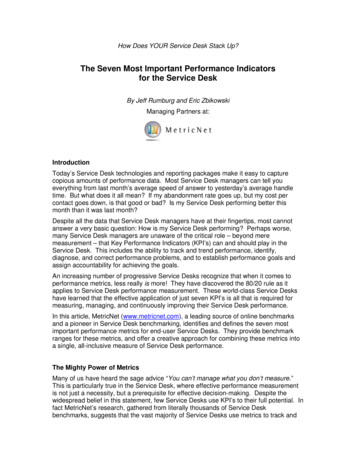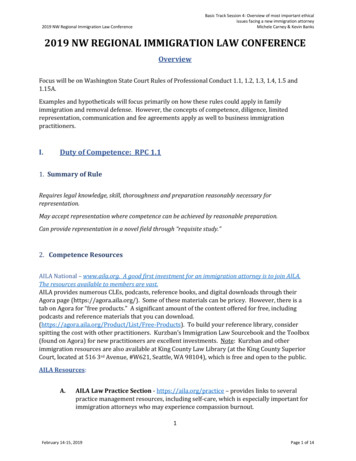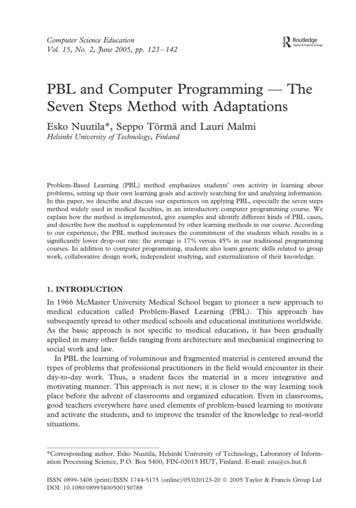
Transcription
How Does YOUR Service Desk Stack Up?The Seven Most Important Performance Indicatorsfor the Service DeskBy Jeff Rumburg and Eric ZbikowskiManaging Partners at:IntroductionToday’s Service Desk technologies and reporting packages make it easy to capturecopious amounts of performance data. Most Service Desk managers can tell youeverything from last month’s average speed of answer to yesterday’s average handletime. But what does it all mean? If my abandonment rate goes up, but my cost percontact goes down, is that good or bad? Is my Service Desk performing better thismonth than it was last month?Despite all the data that Service Desk managers have at their fingertips, most cannotanswer a very basic question: How is my Service Desk performing? Perhaps worse,many Service Desk managers are unaware of the critical role – beyond meremeasurement – that Key Performance Indicators (KPI’s) can and should play in theService Desk. This includes the ability to track and trend performance, identify,diagnose, and correct performance problems, and to establish performance goals andassign accountability for achieving the goals.An increasing number of progressive Service Desks recognize that when it comes toperformance metrics, less really is more! They have discovered the 80/20 rule as itapplies to Service Desk performance measurement. These world-class Service Deskshave learned that the effective application of just seven KPI’s is all that is required formeasuring, managing, and continuously improving their Service Desk performance.In this article, MetricNet (www.metricnet.com), a leading source of online benchmarksand a pioneer in Service Desk benchmarking, identifies and defines the seven mostimportant performance metrics for end-user Service Desks. They provide benchmarkranges for these metrics, and offer a creative approach for combining these metrics intoa single, all-inclusive measure of Service Desk performance.The Mighty Power of MetricsMany of us have heard the sage advice “You can’t manage what you don’t measure.”This is particularly true in the Service Desk, where effective performance measurementis not just a necessity, but a prerequisite for effective decision-making. Despite thewidespread belief in this statement, few Service Desks use KPI’s to their full potential. Infact MetricNet’s research, gathered from literally thousands of Service Deskbenchmarks, suggests that the vast majority of Service Desks use metrics to track and
The Seven Most Important KPI’s for Service Deskstrend their performance – but nothing more! Unfortunately, in this mode, a Service Deskmisses the real value of performance measurement by failing to exploit the diagnosticcapabilities of KPI’s.The true potential of KPI’s can only be unlocked when they are used holistically, not justto measure performance, but also to: Track and trend performance over time Benchmark performance vs. industry peers Identify strengths and weaknesses in the Service Desk Diagnose and understand the underlying drivers of performance gaps Prescribe actions to improve performance Establish performance goals for both individuals and the Service Desk overallIn short, performance measurement and management is a critical discipline that must bemastered for any Service Desk that aspires to world-class performance.A simple example will serve to illustrate how this discipline is applied. MetricNet recentlyworked with a Service Desk at a regional bank that was struggling with low levels ofcustomer satisfaction. A quick benchmark of the KPI’s showed that the bank’s FirstContact Resolution (FCR) – the number of contacts resolved on initial contact with thecustomer – was low, at only 61%. Given the strong correlation between FCR andCustomer Satisfaction (Figure 1 below), the bank initiated a number of initiativesdesigned to increase the FCR. These included more agent training hours, and theimplementation of performance goals for FCR. As a result, over a period of eightmonths the bank realized a substantial increase in FCR, and hence customersatisfaction (Figure 2 below).Figure 1: First Contact Resolution vs. Customer Satisfaction MetricNet, LLC, All rights reservedhttp://www.metricnet.comPage 2
The Seven Most Important KPI’s for Service DesksFigure 2: FCR Drives Customer SatisfactionThe Seven Most Important Service Desk MetricsThe average customer service Service Desk tracks more than 25 metrics. A list of themost common metrics is shown below (Figure 3). This is a classic example of quantityover quality, where Service Desks falsely assume that they are doing somethingproductive and good by tracking all of these metrics. The vast majority of these metrics,however, are only marginally relevant – at best! The seven that really matter are asfollows: Cost per Contact Customer Satisfaction Agent Utilization First Contact Resolution Rate First Level Resolution Rate Agent Satisfaction Aggregate Service Desk PerformanceThese seven metrics represent the 80/20 rule when it comes to Service Deskperformance: 80% of the value you receive from performance measurement andmanagement in your Service Desk can be derived from these seven simple metrics!How do we know these are the most important metrics? Is it a hunch? Suspicion? Anacademic exercise? No, it’s none of the above. We know that these are the sevenmetrics that matter most because the empirical evidence from more than a thousandService Desk benchmarks supports this conclusion. But let us explain why thesemetrics are so critically important. MetricNet, LLC, All rights reservedhttp://www.metricnet.comPage 3
The Seven Most Important KPI’s for Service DesksFigure 3: Common Service Desk MetricsOne goal of every business is to achieve the highest possible quality at the lowestpossible cost. It stands to reason, therefore, that cost and quality should be measuredon an ongoing basis. In fact, many would argue that cost and quality are the only twothings that really matter. In a Service Desk, the most effective cost metric is cost percontact, and the best indicator of quality is customer satisfaction. With this premise inmind, it’s relatively easy to come up with the next two metrics on our list: First ContactResolution (FCR), and Agent Utilization.Earlier in this article, we talked about the importance of using metrics as a diagnostictool to improve performance. So we have to ask ourselves, if customer satisfaction isone of the “foundation metrics” in the Service Desk, how can we affect it? How can weimprove it? Put another way, if customer satisfaction is suffering, what is the diagnosis?Well, it turns out that customer satisfaction is affected by a whole range of otherperformance variables, including Average Speed of Answer (ASA), Call Quality, andHandle Time, to name just a few. But the single biggest driver of customer satisfaction –by far – is FCR! The strong correlation between these two metrics was illustrated earlierin Figure 1. Nine times out of ten when customer satisfaction needs to improve, this canbe achieved by increasing the FCR. This is why world-class Service Desks pay so muchattention to this metric. They engage in a variety of tactics to continuously improve FCR,including agent training, investments in knowledge bases, and agent incentives tied toimprovements in FCR.But what about Cost per Call, the other foundation metric in the Service Desk? It iscommon knowledge that labor, i.e. personnel, is the single biggest expense in theService Desk. In fact, for the average Service Desk, 67% of all costs are labor related:salaries, benefits, incentive pay, and contractors. By definition, then, labor costs are thegreatest lever we have to reduce the cost per call. MetricNet, LLC, All rights reservedhttp://www.metricnet.comPage 4
The Seven Most Important KPI’s for Service DesksThe best measure of labor efficiency is agent utilization. Because labor costs representthe overwhelming majority of Service Desk expenses, if agent utilization is high, the costper call will inevitably be low. Conversely, when agent utilization is low, labor costs, andhence cost per call, will be high. This is illustrated in Figure 4 below.Figure 4: Agent Utilization vs. Cost per ContactJust as world-class Service Desks are obsessive about maintaining a high FCR, they areequally committed to keeping their agent utilization rates high. This, in turn, has theeffect of minimizing cost per call as illustrated above. That said, high utilization ratestaken to the extreme, can actually increase your costs by driving agent turnover rateshigher. Whenever utilization numbers approach 70% - 80%, that Service Desk will seerelatively high agent turnover rates because they are pushing the agents too hard.Extremely high utilization leads to burnout, and that, in turn, leads to turnover.Turnover is one of the most costly things that a Service Desk can experience. In orderto proactively manage agent turnover, best-in-class Service Desks focus on “careerpathing,” training, and frequent coaching sessions. The more time spent off the phones,the more training agents receive, and the more career coaching they receive, the lowerthe turnover will be. This has to be leavened, of course, with the need to keep agentsproductive on the phones.The formula for determining agent utilization is somewhat complicated. It factors in thelength of the work day, break times, vacation and sick time, training time and a numberof other factors. But there is an easy way to approximate agent utilization without goingto all this trouble: MetricNet, LLC, All rights reservedhttp://www.metricnet.comPage 5
The Seven Most Important KPI’s for Service DesksLet’s say, for example that the agents in a particular Service Desk handle an average of500 contacts per month at an average handle time of 10 minutes. Additionally, theseagents work an average of 21 days per month, and their work day is 7.5 hours aftersubtracting lunch and break times. The simplified utilization formula above would workout to the following:Once again, this is not a perfect measure of agent utilization, but it is quick and easy,and gets you within 5% of the true agent utilization figure.The next KPI on the list of “must have’s” is First Level Resolution Rate. This metric is aproxy for Total Cost of Ownership (TCO), and is a critical measure of overall ServiceDesk efficiency. Without this metric, it is very possible for a service desk to achieve alow Cost per Contact, and hence appear to be very efficient, but in fact be driving a veryhigh TCO. Specifically, if the Service Desk is achieving a low Cost per Contact bytransferring and escalating contacts to other support levels – Level 2, Level 3, DesktopSupport, Vendor Support, etc. – then it is also dramatically increasing the TCO.Figure 5 below illustrates this concept.Figure 5: Average Cost per Incident by Support Level MetricNet, LLC, All rights reservedhttp://www.metricnet.comPage 6
The Seven Most Important KPI’s for Service DesksThe next metric, Agent Satisfaction, is strongly correlated with many other metrics on theService Desk. High levels of Agent Satisfaction lead to lower turnover, lowerabsenteeism, lower handle times, and higher First Contact Resolution Rates. These, inturn, result in lower Cost per Contact, and higher Customer Satisfaction. ProgressiveService Desks therefore measure Agent Satisfaction at least twice per year, and takesteps to ensure that they are maintaining high levels of Agent Satisfaction. Specifically,World-Class service desks provide training, career pathing, and coaching for theiragents at well above industry average levels. This, in turn, leads to high levels of agentsatisfaction and morale.We have now discussed six of the seven metrics that are most important for managing aService Desk. What about the seventh metric? What is aggregate Service Deskperformance, and how do we measure it? Can a single measure really tell us the overallperformance of our Service Desk? The answer is yes, but as the name suggests, itinvolves aggregating a number of measures to come up with a combined score forService Desk performance.MetricNet’s research shows that establishing a single, overall score for your ServiceDesk is critical. We call this measure the Balanced Score because it truly doescommunicate a balanced picture of Service Desk performance. This is a mechanismthat utilizes the key measures tracked in a Service Desk, including such things as costper call, ASA and call abandonment rate, and rolls them into a single, aggregatemeasure of Service Desk performance.The value of this metric, when tracked over time, is that it enables Service Desks todetermine whether overall performance is improving or declining. Oftentimes, when aService Desk attempts to communicate its performance to other stakeholders in thebusiness, particularly to lay people who do not understand Service Desk operations,they quickly become overwhelmed by the minutia of such measures as speed-of-answerand abandonment rate, and they are confused as to how to interpret the results. Theyare likely to focus in on one, easily-understood measure like abandonment rate or speedof answer, and draw conclusions about overall Service Desk performance from thesetwo (relatively unimportant) measures. This is a classic case of “missing the forest forthe trees”. It is therefore absolutely critical to communicate the overall performance ofthe Service Desk, and the Balanced Score does that for you. It allows the aggregation ofa whole series of measures, the normalization of those measures, and the creation asingle all-encompassing indicator of Service Desk performance on a monthly basis. Inthis way, the Service Desk can track its overall performance, and, in any given month,may see costs go up or customer satisfaction go down or speed of answer increase, butthese individual measures take on a secondary level of importance because theBalanced Score provides a more complete and accurate portrait of Service Deskperformance.Figure 6 on the next page illustrates how the Balanced Score is constructed. MetricNet, LLC, All rights reservedhttp://www.metricnet.comPage 7
The Seven Most Important KPI’s for Service DesksFigure 6: The Service Desk Balanced ScorecardFigure 7: Trending the Balanced Score MetricNet, LLC, All rights reservedhttp://www.metricnet.comPage 8
The Seven Most Important KPI’s for Service DesksFigure 7 above illustrates the Balanced Score for one Service Desk over a twelve monthperiod. Notice how you can see at a glance which months had improving performance(the balanced score goes up), and which months had declining performance (thebalanced score goes down). The purple background on the chart represents the twelvemonth trailing average score. The good news for this Service Desk is that the overalltrend is in a positive direction.Metrics that Don’t Matter (as much)Some of the most commonly tracked metrics in the Service Desk, including ASA andCall Abandonment Rate, did not make the cut of the top seven. Why is this? Have wemissed something? Why are ASA and Call Abandonment Rate, which are so widelyfollowed in this industry, not included in the top seven? The answer is simple they justdon’t matter! That’s right; these metrics which are the foundation of so many servicelevel agreements have almost no impact on customer satisfaction. Worse yet, as thesemetrics are pushed lower (i.e., lower ASA and lower Call Abandonment Rates) the costper contact increases geometrically! These facts fly in the face of almost all ServiceDesk wisdom, which holds that ASA and Call Abandonment Rate should be driven aslow as possible.If nothing else, in this paper we hope to shatter the myth that ASA and CallAbandonment Rate are important metrics. The reality is that these measures can yieldunintended results if pushed too low. They will increase your costs without anycorresponding increase in customer satisfaction. In the next section of this article, wewill provide some guidelines for appropriate ASA and Call Abandonment Rate targets.And, as you probably suspect, they are higher than you might think.As we stated earlier in this article, these conclusions are based on empirical evidence.Figures 8, 9, 10, and 11 below show how little these two metrics affect customersatisfaction, yet how much they can increase your costs if driven too low.Figure 8: ASA vs. Customer Satisfaction MetricNet, LLC, All rights reservedhttp://www.metricnet.comPage 9
The Seven Most Important KPI’s for Service DesksFigure 9: Average Speed of Answer vs. Cost per ContactFigure 10: Call Abandonment vs. Customer Satisfaction MetricNet, LLC, All rights reservedhttp://www.metricnet.comPage 10
The Seven Most Important KPI’s for Service DesksFigure 11: Call Abandonment vs. Cost per ContactThe essence of this data is that as long as ASA is less than 10% of handle time, andCall Abandon Rate is less than 10%, there is almost no negative impact on CustomerSatisfaction. However, if ASA and Call Abandonment rates increase much above thesethreshold values, Customer Satisfaction will begin to drop off.The flip side is that if these service levels become too aggressive (e.g. ASA and CallAbandon Rates that are too low), the costs will increase with no corresponding increasein Customer Satisfaction. This suggests that there is an optimum operating point forservice levels whereby Customer Satisfaction is maximized while costs are minimized.This point occurs approximately at the point where ASA 10% of AHT, and CallAbandonment Rate is at 10%. For practical purposes, however, most service deskstend to operate a bit more conservatively, maintaining their ASA below 10% of handletime, and their Call Abandon Rate below 10%.Please keep in mind that ASA and Call Abandonment Rate are not the only “low value”metrics tracked by many Service Desks. Figure 3 above shows 25 of the mostcommon metrics tracked by Service Desks, and the vast majority of these metrics fallinto the same category as ASA and Call Abandonment: they add little if any value.Again, if you keep in mind the 80/20 rule of Service Desk performance measurement,and focus on the seven metrics identified in the previous section, you can operate yourService Desk very efficiently and effectively.ConclusionMost Service Desks commit two major mistakes when it comes to performancemeasurement: 1) they track too many metrics, and 2) they do not exploit the full potentialof their performance metrics as a diagnostic tool. MetricNet, LLC, All rights reservedhttp://www.metricnet.comPage 11
The Seven Most Important KPI’s for Service DesksIn this article we have shown that you can effectively track and trend your Service Deskperformance using just seven KPI’s. The two “foundation metrics” that every ServiceDesk should track on an ongoing basis are Cost per Contact and Customer Satisfaction.The next two metrics in the top seven are the ones that have the greatest influence oncost and customer satisfaction: Agent Utilization and First Contact Resolution. Then wesuggest tracking First Level Resolution because it is a proxy for Total Cost ofOwnership, and is an overall indicator of Service Desk efficiency. The sixth metric onour list, Agent Satisfaction, is important because it is so strongly correlated with anumber of important metrics on the Service Desk, including Cost per Contact andCustomer Satisfaction. And the final metric, what we call an aggregate metric because itprovides an overall measure of Service Desk performance, is the Balanced Score.These seven metrics not only allow you to effectively measure your Service Deskperformance, but they enable you to: Track and trend performance over time Benchmark performance vs. industry peers Identify strengths and weaknesses in the Service Desk Diagnose and understand the underlying drivers of performance gaps Prescribe actions to improve performance Establish performance goals for both individuals, and the Service Desk overallWhen it comes to
Conversely, when agent utilization is low, labor costs, and hence cost per call, will be high. This is illustrated in Figure 4 below. Figure 4: Agent Utilization vs. Cost per Contact Just as world-class Service Desks are obsessive about maintaining a high FCR, they are equally committed to kee











